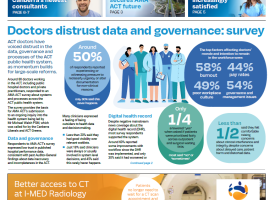Record wait times for mental health patients in EDs remain unchanged
Patients with mental health conditions are continuing to spend an average of seven hours waiting for care in public hospital emergency departments, in conditions that exacerbate symptoms and lead to attacks on hospital staff.

The difficulties facing patients with mental illness and healthcare workers in Australia’s logjammed emergency departments are detailed in the Australian Medical Association’s latest Public Hospital Report Card: Mental Health Edition.
AMA President Dr Danielle McMullen said that a year on from the last report, which showed wait times for patients with mental illness were the longest on record, there had been no improvement overall.
“This means very unwell people are waiting for an unacceptably long time in completely inappropriate settings, with bright lights and noise, potentially further exacerbating their symptoms,” Dr McMullen said.
“An increasing number of patients are presenting to health services in acute mental health crisis, requiring urgent intervention and coordinated care. For many of these patients, a hospital admission is required and the journey through the ED is a daunting and overwhelming experience.
“Patients are facing long waits in bright, noisy environments that often lead to increased agitation and distress. Sadly, this can lead to either verbal or physical assaults on staff, with violence in public hospitals continuing to rise.”
Dr McMullen said there were several contributing factors to the issue, including exit block; a shortage of inpatient mental health unit beds; a lack of investment in community and primary mental healthcare; and a lack of interoperable electronic patient records, resulting in time-consuming administrative burdens.
“In my practice I see the significant burden of mental illness — from patients with early, mild symptoms, to patients with chronic and complex conditions. I see firsthand how important it is to have a connected and well-functioning mental health system.
“We need to properly resource general practice, psychiatry and community mental health services with acute care teams to provide best practice care and take the pressure off emergency departments.
“Growing demand and under-resourcing is leading to clinically unacceptable long waiting lists for these services.”
Pressure in Australia’s logjammed public hospitals is mounting with the AMA’s 2025 Public Hospital Report Card (released in February) revealing a troubling combination of record-high waiting times and historically low bed capacity per person across the public hospital system.
“Alarmingly, these issues extend to mental health wards, where the most recent data shows just 27 specialised mental health beds per 100,000 people — the equal lowest capacity ever recorded,” Dr McMullen said.
The AMA’s report mirrors findings in the upcoming Australasian College for Emergency Medicine (ACEM) Still Waiting report, which revealed rising numbers of mental health-related presentations to EDs, particularly among Aboriginal and Torres Strait Islander peoples and those aged over 65 years, as well as excessively long waits for admission, with 10 per cent of patients with a mental health diagnosis waiting more than 23 hours for an inpatient bed in 2023–24.
“The consequences of this are profound — for people who wait too long or do not receive appropriate care, for families and communities who carry the weight of crisis, and for staff working under relentless pressure,” ACEM President Dr Stephen Gourley said. “Without meaningful investment in community-based mental health services, the system will remain reactive, costly and unsustainable.”
Dr McMullen said a unified approach across the healthcare system was needed across governments to deal with the complex and layered nature of mental healthcare.
“Governments must focus on funding accessible, high-quality mental health supports outside of hospital environments,” Dr McMullen said.
“This report also underscores the pressing need for increased investment in the public hospital system,” Dr McMullen said.
“The next National Health Reform Agreement (NHRA) must be delivered as soon as possible, and it must contain the investment needed to ensure all patients get the care they need, when they need it.”



